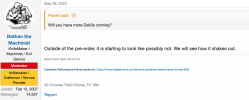Hey
 Nathan the Machinist
!
Nathan the Machinist
!
I just saw the upcoming friday sale. I just wanted to ask the hardness and behind the edge thickness of CruWear variation of the knife. It would be great to have that knife in CruWear if it is harder and thinner than delta3V version.
As you do not usually make knives in CruWear, it would be great (if you could of course) to have side to side comparisons with delta3V, like the video you did with MagnaCut for DEK1.
For me the selling point of CruWear would be the edge stability at higher hardnesses (i.e. higher toughness at higher hardness compares with delta 3v). With regular knife specs. (i.e. thick geometry-20 tho behind the edge- and 60.5 HRC), I do not think CruWear has much more to offer compared with delta 3V other than reduced stain resistance and bit bump in wear resistance.
Thanks
I just saw the upcoming friday sale. I just wanted to ask the hardness and behind the edge thickness of CruWear variation of the knife. It would be great to have that knife in CruWear if it is harder and thinner than delta3V version.
As you do not usually make knives in CruWear, it would be great (if you could of course) to have side to side comparisons with delta3V, like the video you did with MagnaCut for DEK1.
For me the selling point of CruWear would be the edge stability at higher hardnesses (i.e. higher toughness at higher hardness compares with delta 3v). With regular knife specs. (i.e. thick geometry-20 tho behind the edge- and 60.5 HRC), I do not think CruWear has much more to offer compared with delta 3V other than reduced stain resistance and bit bump in wear resistance.
Thanks
Last edited:


